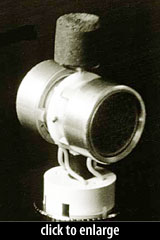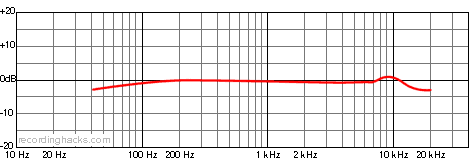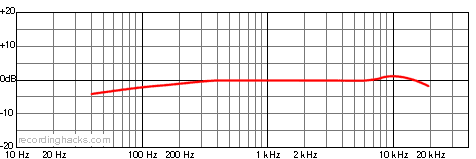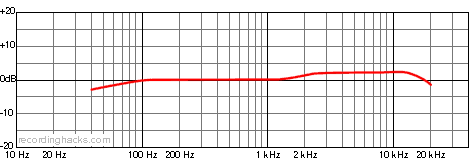

 Neumann KM 86
Neumann KM 86
Multi-Pattern Condenser Microphone
The KM 86 is a multipattern FET condenser microphone with two KK84 small-diaphragm Cardioid capsules mounted back-to-back. This mic was essentially a phantom-powered FET version of the KM 66 tube mic; both models contained a switch on the mic body allows selection of Cardioid, Omnidirectional, or figure-of-8 polar patterns.
 The use of two fixed-Cardioid capsules mounted back-to-back was a relatively recent innovation for Neumann. The idea was developed in the mid-1960s and first commercialized in the KM-66, released in 1966.
The use of two fixed-Cardioid capsules mounted back-to-back was a relatively recent innovation for Neumann. The idea was developed in the mid-1960s and first commercialized in the KM-66, released in 1966.
Unlike large-diaphragm multipattern mics, which create switchable polar patterns by combining the output of two sides of a dual-diaphragm capsule in a variety of ways, the KM66, KM76, and KM86 utilize twin single-sided capsules developed for the fixed-Cardioid KM-84. The two capsules are mounted back-to-back, with 1cm of space between the diaphragms.
Klaus Heyne
The functional difference for generating figure eight with one capsule, a combined backplate and two diaphragms or two entirely separate cardioid capsules is two-fold.
One, the physical distance, measured from diaphragm to diaphragm, is slightly bigger on the KM86 compared with, say, a U87. So there is some additional time delay involved.
Two, each of the two cardioid capsules which form the figure eight on a KM86 is somewhat ‘purer’ in as much as the directional discrimination for each cardioid is derived from sound waves hitting the back plate (and then the inside of the diaphragm) directly, rather than traveling through another diaphragm, as in the case of combined backplate systems, like K67/K47, etc.
The increase in space between the two diaphragms, as compared to a dual-diaphragm capsule, results in greater phase differences for low-frequency signals striking the two capsules; this in turn leads to an improvement in low-frequency response when the mic is in Figure-of-8 mode.
Because the figure-8 performance of most dual-diaphragm capsules suffers in the low frequencies, the KM-86 and related microphones offer superior low-frequency reproduction.
Neumann
Polar diagrams of typical dual-diaphragm microphones indicate that the reverse attenuation of the cardioid pickup pattern decreases remarkably towards the low frequencies. When the two capsule halves are activated at the same time, the backside part adds a much higher share of the whole signal. This generates an narrower figure-8 pattern in the low frequencies and an uneven response due to changes in distance.
In the KM 66, the cardioid and figure-8 patterns feature an accurate representation of low frequencies, even in such a case where the microphone is used at a greater distance from the sound source.
The capsule assembly was shockmounted, to reduce mechanical noise. Over time, these rubber components can become brittle, reducing their effectiveness.
 The microphone’s name is descriptive: KM is for Kleine Mikrofon (“small microphone”). The digit 8 indicates the use of P48 phantom power. The digit 6 indicates a multipattern microphone.
The microphone’s name is descriptive: KM is for Kleine Mikrofon (“small microphone”). The digit 8 indicates the use of P48 phantom power. The digit 6 indicates a multipattern microphone.
A second switch, on the rear of the microphone body, enabled a -10dB pad.
The KM86 was available in two colors, with two possible output connectors, yielding four possible configurations:
- KM 86 - 3-pin Binder/Tuchel jack, silver/nickel finish, 175mm length
- KM 86 i - 3-pin XLR jack, silver/nickel finish, 185mm length
- KM 86 mt - 3-pin Binder/Tuchel jack, dark matte gray finish, 175mm length
- KM 86 i mt - 3-pin XLR jack, dark matte gray finish, 185mm length
Like many of the Neumann microphones of its era, the KM86/KM86i could be modified for 50Ω output impedance, rather than the standard 200Ω. Mics configured for 50Ω from the factory were marked with a red dot next to the serial number.
The KM86/KM86i specifications changed during its 18-year production run. For example, an early catalog specifies the sensitivity at 0.7mV/μb (7mV/Pa). But the user guide from 1980 specs the sensitivity at 9.5 mV/Pa.
The KM86 microphone was discontinued in 1986.
The Neumann KM 86 is also known as: KM86.
The mic was released in 1968.
Specifications
| Frequency Response - OmnidirectionalClick Graph to Compare! |
|---|
 |
| Frequency Response - CardioidClick Graph to Compare! |
 |
| Frequency Response - BidirectionalClick Graph to Compare! |
 |
| Pickup Patterns | Pads & Filters |
|---|---|
|
Omnidirectional
(9.5 mV/Pa; 40 - 16,000 Hz) Cardioid (7 mV/Pa; 40 - 16,000 Hz) Bidirectional (7 mV/Pa; 40 - 16,000 Hz) |
|
| Capsule Dimensions | Impedance | SPL/Noise |
|---|---|---|
| Diameter n/a |
200 Ohms (Low) | Max SPL: 131 dB Self-noise: 19.0 dB(A) |
| Weight | Length | Max Diameter | Interface(s) |
|---|---|---|---|
| 200g (7.05oz) | 175mm (6.89'') | n/a |
|
| Power Specifications |
|---|
|
Did we get anything wrong on this page? Please let us know!


